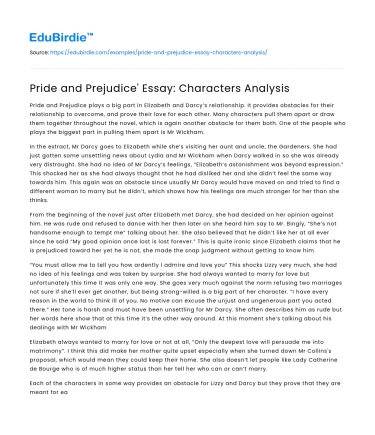Introduction
Jane Austen's "Pride and Prejudice" is renowned for its intricate character portrayals and dynamic interactions. Set in the early 19th century, the novel offers a satirical exploration of the British landed gentry through its protagonist, Elizabeth Bennet, and her evolving relationship with Mr. Darcy. The characters in "Pride and Prejudice" are not merely vehicles for the plot but are complex beings whose development is crucial to the thematic depth of the novel. This essay will delve into the multifaceted nature of key characters like Elizabeth Bennet and Mr. Darcy, examining their personal growth and the societal influences that shape their personas. Through an analysis of these characters, the essay aims to reveal how Austen uses them to critique social norms and elevate individual virtues over societal expectations.
Elizabeth Bennet: A Paradigm of Intelligence and Integrity
Elizabeth Bennet, the second of the five Bennet sisters, emerges as a character who defies the conventional expectations of women in her time. Her intelligence, wit, and independence distinguish her from the typical female archetypes prevalent in 19th-century literature. Elizabeth's sharp intellect allows her to perceive the follies and pretensions of those around her, a skill that Austen uses to critique the social hierarchies of her era. For instance, Elizabeth's rejection of Mr. Collins' marriage proposal is a pivotal moment that underscores her commitment to personal integrity over economic security. In this instance, Austen challenges the societal norm that marriage is a woman's ultimate goal, suggesting instead that self-respect and compatibility should take precedence.
Save your time!
We can take care of your essay
- Proper editing and formatting
- Free revision, title page, and bibliography
- Flexible prices and money-back guarantee
Despite her strengths, Elizabeth is not without flaws. Her initial prejudice against Mr. Darcy, fueled by pride and misjudgments, highlights her susceptibility to error. Austen masterfully portrays Elizabeth's personal growth through her gradual realization of Darcy's genuine virtues. The turning point in Elizabeth's character arc occurs upon reading Darcy's letter, where she confronts her own biases and misconceptions. This introspection leads to a more nuanced understanding of Darcy and, ultimately, herself. Elizabeth's journey from prejudice to self-awareness exemplifies Austen's advocacy for introspection and moral growth, positioning Elizabeth as a character who embodies both the strengths and vulnerabilities inherent in human nature.
Mr. Darcy: A Complex Portrait of Pride and Transformation
Fitzwilliam Darcy, initially perceived as the epitome of arrogance and pride, undergoes a profound transformation throughout the narrative. At the novel's outset, Darcy's aloof demeanor and disdain for the provincial society of Meryton reinforce Elizabeth's negative impressions. His infamous remark at the Netherfield ball, where he dismisses Elizabeth as "tolerable, but not handsome enough to tempt me," cements his reputation as haughty and dismissive. However, Austen gradually peels back the layers of Darcy's character to reveal a man whose pride is not merely a flaw but a defense mechanism shaped by his social standing and responsibilities.
Darcy's transformation is catalyzed by his growing admiration for Elizabeth's forthrightness and intelligence. His initial proposal to Elizabeth, though earnest, is marred by his condescending attitude and emphasis on social disparity. Elizabeth's rejection serves as a catalyst for Darcy's introspection and subsequent change. He acknowledges his faults, stating, "I have been a selfish being all my life, in practice, though not in principle." Darcy's efforts to amend his past actions, particularly his intervention in Lydia Bennet's scandal, exemplify his genuine commitment to personal growth. Through Darcy, Austen illustrates that true nobility lies not in social standing but in one's capacity for self-improvement and empathy.
Supporting Characters: Catalysts for Reflection and Change
The supporting characters in "Pride and Prejudice" play crucial roles in the main characters' development and in enhancing the novel's social critique. Characters such as Mr. Collins and Lady Catherine de Bourgh serve as embodiments of the societal pressures and class prejudices that Elizabeth and Darcy must navigate. Mr. Collins, with his obsequiousness and blind adherence to social norms, contrasts sharply with Elizabeth's independent spirit, highlighting her resistance to societal conformity.
Similarly, Lady Catherine's attempts to control the narrative of Elizabeth and Darcy's relationship underscore the rigid class distinctions of the time. Her confrontation with Elizabeth is a testament to Elizabeth's resolve and rejection of classist ideologies. Furthermore, characters like Jane Bennet and Mr. Bingley offer a foil to Elizabeth and Darcy's more tumultuous relationship, demonstrating that mutual respect and understanding are foundational to successful partnerships. Austen uses these supporting characters not only to advance the plot but to reinforce the novel's central themes of individuality, social critique, and the transformative power of love.
Conclusion
In conclusion, the characters in Jane Austen's "Pride and Prejudice" are instrumental in conveying the novel's critique of societal norms and the value of personal virtues. Elizabeth Bennet and Mr. Darcy, through their respective journeys of self-discovery and transformation, embody the complexities of human nature and the potential for growth beyond societal constraints. Supporting characters further enrich the narrative, acting as mirrors and foils that challenge and refine the protagonists’ worldviews. Austen's masterful characterizations not only provide rich material for literary analysis but also offer timeless insights into the human condition. By examining her characters, readers are invited to reflect on their own prejudices and the societal influences that shape their identities.






 Stuck on your essay?
Stuck on your essay?

